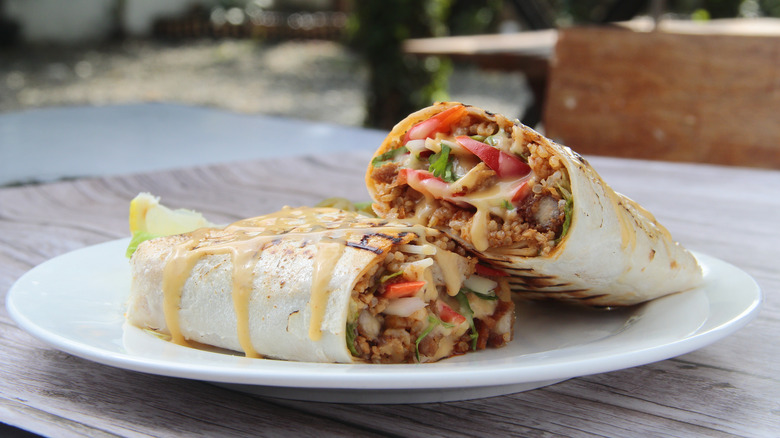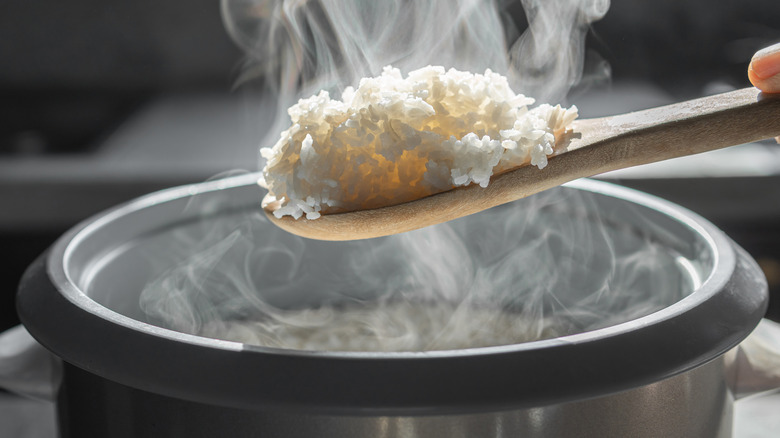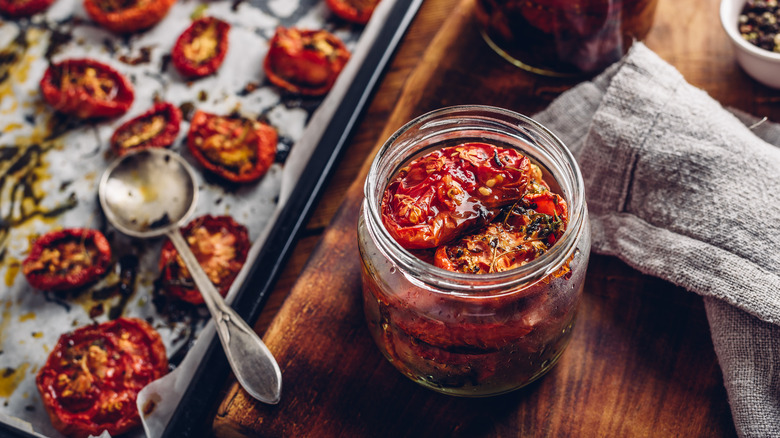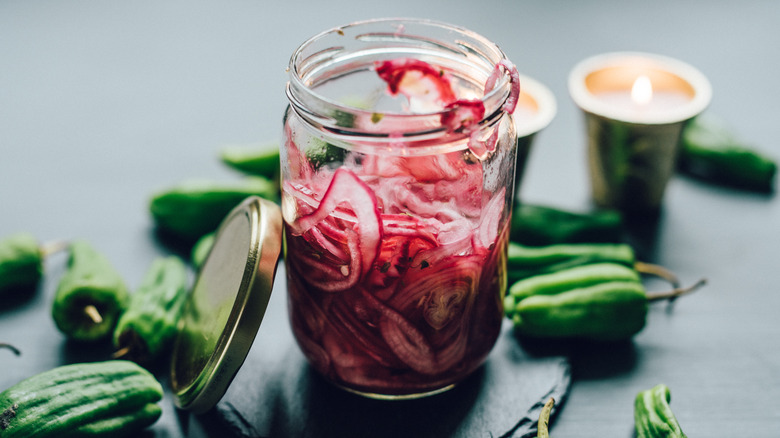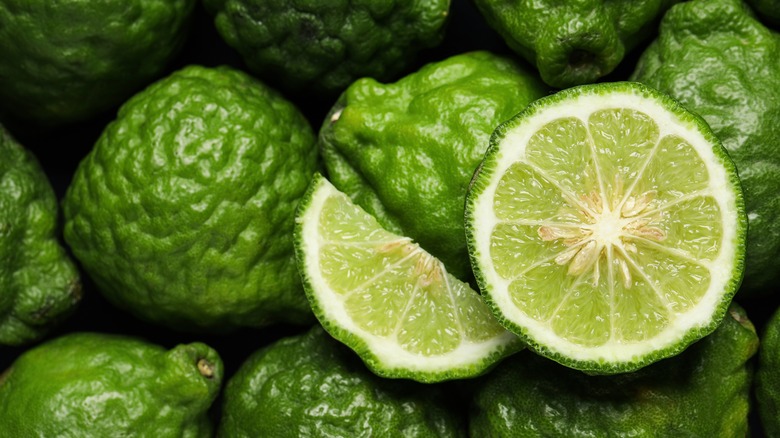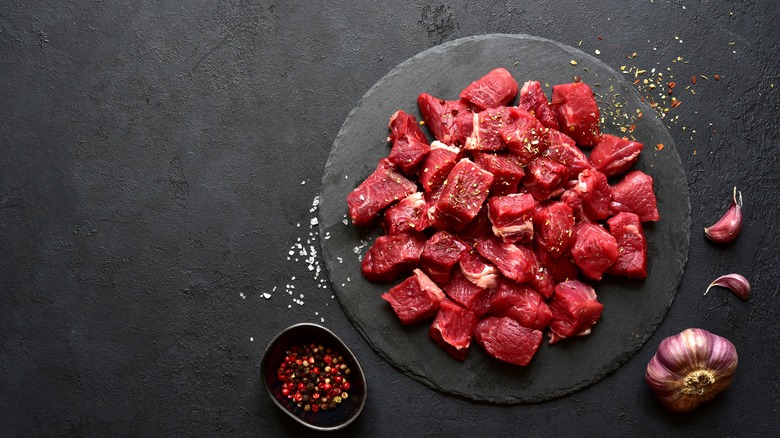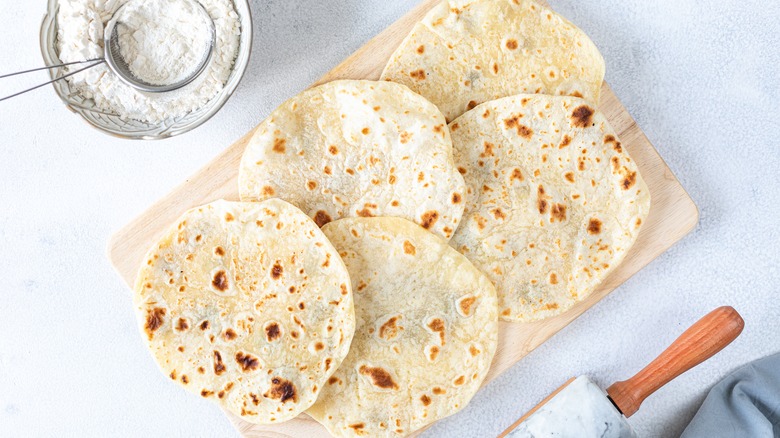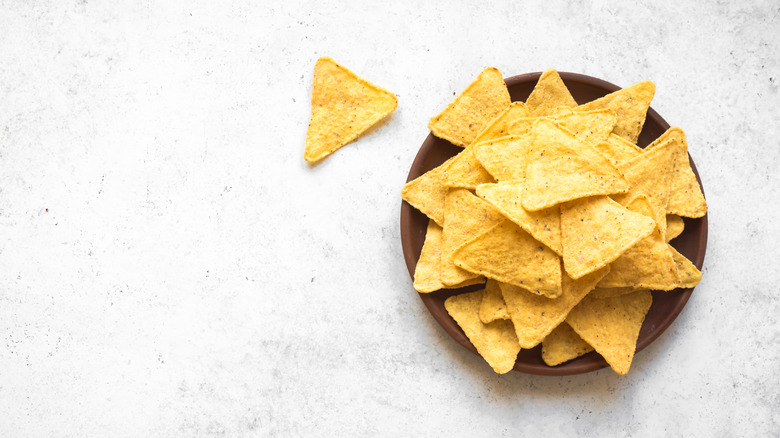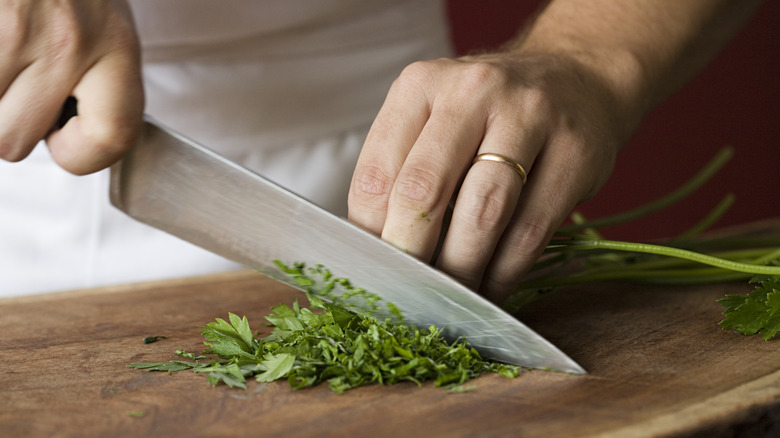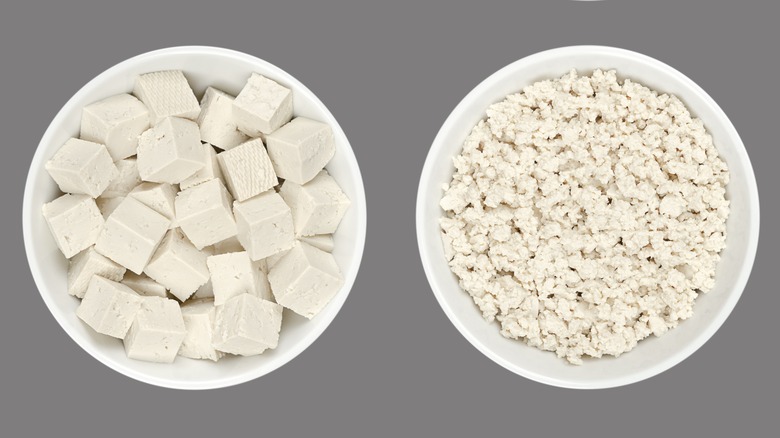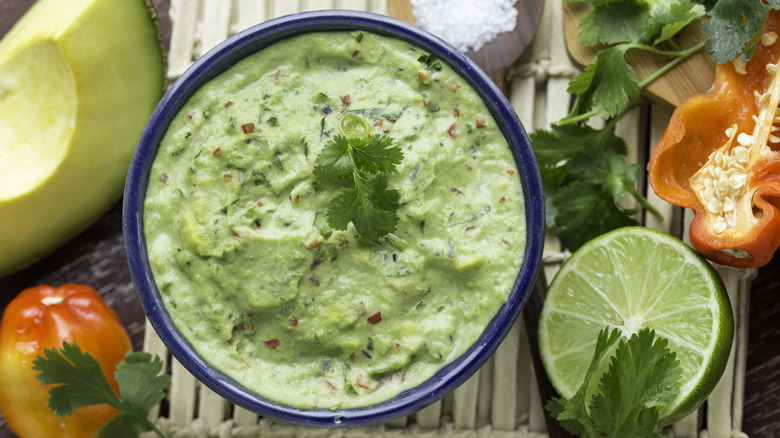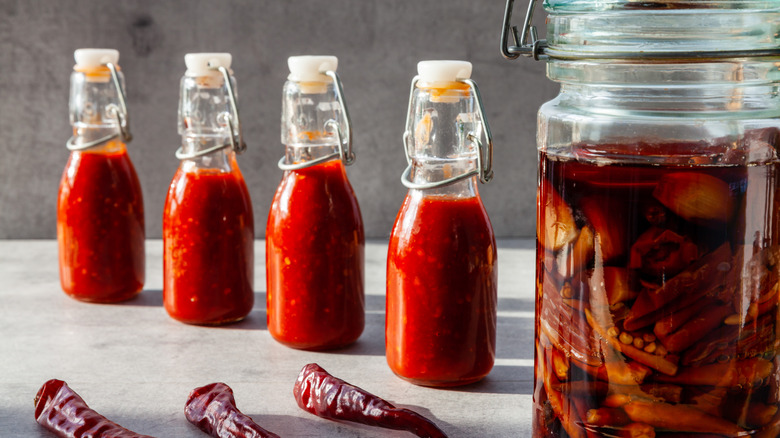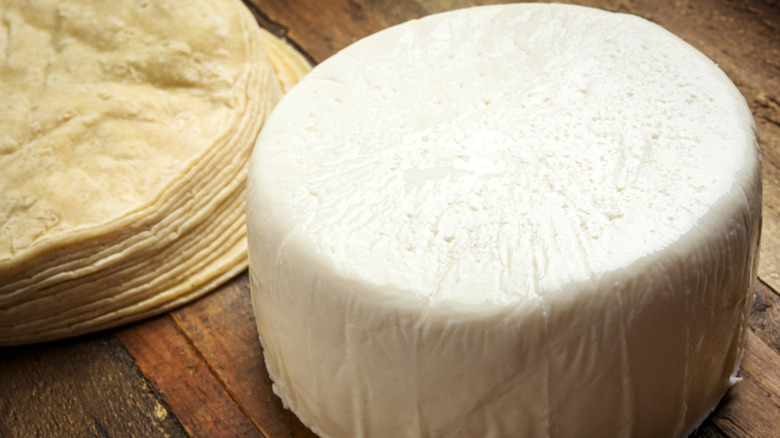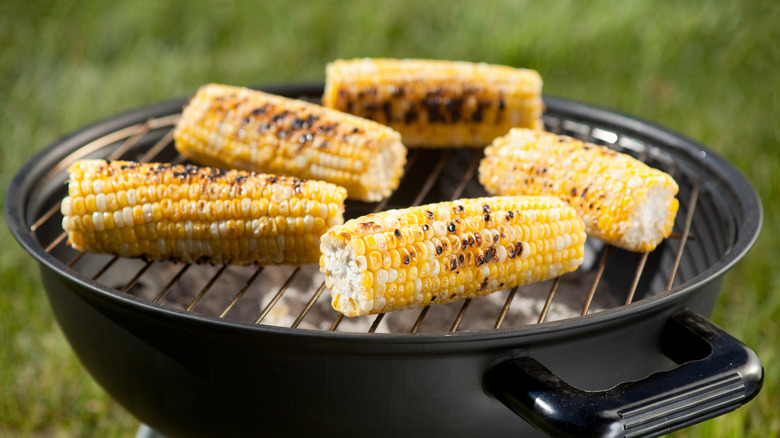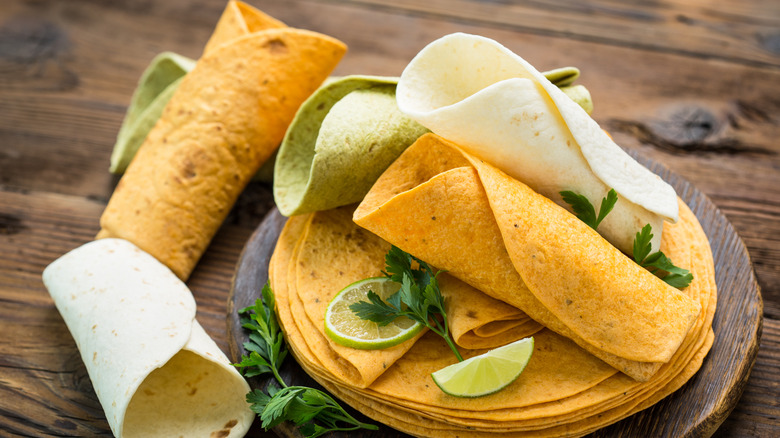14 Ways To Level Up Your Homemade Burritos
The humble burrito is one of the most popular Mexican and American food items across the world. So it might surprise you to learn that its history is actually pretty recent. The burrito was likely invented in Sonora, where the classic elements of the dish, a flour tortilla and a beef filling, are commonly produced. The food began to appear in its early forms in Mexico at the end of the 19th century. But burritos truly hit the mainstream in the United States in the 1930s, when immigrants from the northern Mexican region brought the food with them to California.
From there, the burrito — which translates to little donkey in Spanish, potentially referring to the way that the food, like the equine animal, can carry a lot of different elements on its sturdy, wheat-constructed back — exploded in popularity. Nowadays, burritos can feed people at any point in the day, from the trusty breakfast burrito filled with sausage, egg, and potatoes, to a classically-constructed burrito comprised of beans, rice, protein, cheese, and salsa. But while burritos are never lacking in flavor, in our opinion, they can always be made better. From surprise ingredients to quick and easy cooking hacks, leveling your burrito up has never been easier.
1. Cook your rice in stock for more flavor
Rice is an essential yet sometimes under-appreciated part of the burrito. Rice provides a relatively neutral flavor base for the other ingredients in your wrap to shine through and helps to temper the impact of overly-spiced meats or beans. Different types of rice can also provide different flavors and textures. While white rice gives the burrito a starchy, pillowy layer, brown rice can deliver a nutty, slightly chewy edge and can boost the fiber content of your meal.
But while rice can provide a flavor and texture counterpoint, it can also sometimes drag the taste of your burrito down with it, making everything just a little blander. To avoid this, perform a simple hack by cooking it in stock. Cooking rice in a flavorful stock doesn't just add more salt but all of the nuance added to the liquid from simmering the meat, vegetables, and bones together. Cooking rice in a broth will also impart more flavor to your rice, although it may add slightly less and be less rich than stock due to broth being simpler and less concentrated.
Both broth and stock may also add some nutrients to your rice, thanks to the vitamins and minerals in the liquid. When cooking rice with stock or broth, it's hard to go wrong with a chicken or vegetable flavor. Using beef broth will add a slightly meatier taste to your rice and turn it a darker color.
2. Add some unexpected vegetables
Most burritos will have some form of vegetable in them, but if your burrito is meat-based, they tend not to be the star of the show. But whether you're looking for a new vegetarian filling or just trying to complement your meat in unusual ways, interesting vegetables can provide flavor and texture. Raw vegetables, like finely-shredded carrots or crisp zucchini, can provide a crunchy element that produces a slightly different mouthfeel than lettuce. Opting out your regular greens for a slightly denser option like kale may also give a slightly earthier taste to the burrito and provide vitamins like B6, C, and K.
But if you want to really amp things up, marinated vegetables are the way to go. Sundried tomatoes, marinated in olive oil, are a perfect way to add a serious depth of umami-rich flavor and a chewy, pleasing texture. As an added bonus, they're also high in fiber and vitamin C. Roasted, marinated red peppers can give similar layers of flavor and also provide a sweetness to burritos that complement the spice. Try taking these two vegetables and combining them with some grilled aubergine for a vegetarian burrito that feels simultaneously light and bursting with flavor.
3. Throw in some pickled onions for a sharp tang
The best burritos are able to combine several different flavor and texture notes, with spice, umami, creaminess, and salt all coming together to make an excellent meal. But tanginess can sometimes be overlooked. While hot sauces are able to deliver sourness and vinegary notes alongside their heat, this can often be outweighed by the meatier flavors in the wrap.
But a simple addition of pickled onions will give sharpness to your burrito without overpowering it. Pickled onions can add not only a top note of acid and a light crunch to the whole affair, but as they're often pickled alongside coriander and cumin, they have flavors in them that complement the tastes in burrito spice blends. Any pickled onion work excellently in burritos, although each color has a slightly different flavor. White onions have a gentle sweetness to them, while yellow onions can be a bit stronger. Red onions, meanwhile, are usually the sharpest-tasting and have a peppery, slightly spicy flavor.
If onions aren't your thing, though, never fear — you can basically pickle anything and put it inside a wrap. Cucumbers, radishes, cabbage, and even mangoes are great when pickled; each will add a distinct flavor to a burrito.
4. Add some lime zest for a citrus kick
No burrito is complete without a squeeze of lime juice. But this can also create some problems. Lime juice adds sharpness and tang, but it also necessarily adds more moisture to your burrito. This can be an issue if your burrito is already moisture-rich through the addition of beef simmered in sauce, salsa, and sour cream. Too much moisture in a burrito can start to make everything soggy, and in the worst-case scenario, it can cause your tortilla to split, causing your ingredients to fall out.
But adding lime zest is a great way to add a citrusy flavor without making your wrap too wet. The zest of citrus fruits contains their natural oils, which are what deliver that inimitable flavor. The easiest way to zest a lime is with a fine grater like a Microplane, which breaks it up into small-enough pieces that you won't be biting into a large chunk in your meal. Be careful to only zest the green part off and not go too far into the fruit; zesting the pith into the burrito will make it taste bitter. Additionally, be sparing with your lime zest, as a little can go a long way. The idea is to add a floral, citrus note without overpowering the other flavors in your wrap.
5. Try a different kind of meat
Ground beef is, for many, the standard choice in a burrito, with chicken and pork also being common options. But to make your burrito really pop, try using a different meat. Lamb is one of our top picks for a burrito filling that's different enough to make things interesting, without distracting too much. Lamb has a slightly earthier flavor than beef, with a depth that's really augmented by the spices typically used in burritos, like cumin and chili. It also has a gaminess to it which isn't as strong as other meats, like boar or venison.
There are also some nutritional benefits to choosing lamb over beef. While both types of meat can be fatty, lamb's fats have a higher proportion of monounsaturated and polyunsaturated fats, although it is fattier overall. It's also a great source of vitamin B3 and selenium. If you're opting for lamb, it's always better to go for grass-fed. Choosing grass-fed animals is not only often a more ethical choice, but in the case of lamb, it produces meat that's higher in protein and lower in fat. If lamb's not your thing, you could also opt for white fish or salmon, both of which offer a different flavor while also delivering healthy omega-3 fats.
6. Treat your tortillas well by warming them up
So much emphasis can be placed on a burrito's fillings that we forget what holds it all together. But proper tortilla treatment is essential to the overall success of your wrap. Being too rough with your tortilla, or overfilling it, can lead to things ripping or falling apart, ruining your meal.
A good way to keep the bread pliable is by warming them up before you fold it. Both flour and corn tortillas need slightly different methods for this. Flour tortillas fare slightly better when enveloped in heat, so wrap them up in foil and then pop them in a low-heat oven for around 10-15 minutes. When you take them out, they will be noticeably softer and have slightly more stretch to them. Corn tortillas are best heated up in a hot, dry skillet, using direct heat, flipping them after 20 seconds and removing them when they're soft and flexible.
7. Add some chips for a homemade crunchwrap
Taco Bell's Crunchwrap Supreme has made a big impact in a short space of time. Debuting for the first time in 2005 and becoming a menu staple the next year, the Crunchwrap Supreme quickly became one of the most popular items in the food chain's offerings. While not strictly a burrito, partly due to its hexagonal shape, the Crunchwrap Supreme uses many of the flavors that you might find in one, with spiced beef, cheese, tomatoes, and lettuce, alongside a small tostada that gives each bite maximum crispiness.
Crunchiness can be one of the elements that's hard to come by in a burrito. But by adding in some chips or a crumbled-up tostada, you can make a Crunchwrap Supreme of your very own, albeit in burrito form. Tortilla chips are the natural choice to use with this hack and often come in flavors that complement the other elements of the dish. They also have a robustness that means they won't get too soggy if they come into contact with the other moist ingredients.
But if you don't have any corn chips in, you can mix it up. Lentil chips are one of the best chips to use from both a crunch and health perspective: They're super-crispy and maintain their structure while also providing protein and fiber. Potato chips are also a great option, especially thick-cut chips, which deliver an impressive crunch.
8. Don't forget about herbs
Herbs are an essential component of Mexican cooking, offering a counterpoint to the earthier flavors of spices. But for some reason, they tend to get left out of the equation when it comes to burritos. These wraps tend to emphasize deep, savory flavors and heavier, softer textures and don't require the visual impact that a sprinkle of herbs can capably provide.
But adding a small handful of chopped fresh herbs before closing your burrito can give the meal a brightness you didn't know you needed. Several types of herbs can work well, but cilantro is arguably the top choice. A staple in modern Mexican cuisine, cilantro has a citrus-like, slightly earthy taste, which cuts through the density of burritos, making them an altogether more layered dish.
If you can't find any cilantro, though, parsley will also do the trick. The difference between cilantro and parsley can be subtle, but it all lies in the flavor, with the latter having a slightly milder flavor with a peppery edge. If you like your parsley a little stronger, go for the flat-leaf variety, with curly parsley generally having a more gentle flavor.
9. Use tofu
Burritos are commonly centered around their meat filling, but there are times when you want a break from beef or pork. This is where tofu comes in. Tofu is a high-protein alternative to meat that's low in saturated fat, high in calcium and has a few grams of fiber per serving to boot. It's also infinitely shapeable: You can crumble it into ground beef-style pieces, or cut it into strips or cubes, depending on how you like your meat.
The best thing about using tofu as an alternative, though, is that it takes on flavors incredibly well. In its basic form, tofu has a very mild taste, but its porous nature means that it's great at soaking up marinades and taking on the flavors of any spices you add to it. Try soaking your crumbled tofu in a mixture of spices, dark soy sauce, liquid smoke, and a little lemon juice before frying it all up. This can be a great way to imitate ground beef if you regularly put it in your burritos without any of the potential health implications that come with eating red meat regularly, like heart disease and diabetes, as stated in Harvard Health Publishing.
10. Level up your guacamole with this secret ingredient
For many people, guacamole is a must in burritos. Typically made by mixing together mashed avocado, red onion, jalapeños, and seasonings, classic fresh guacamole can offer a fresh, creamy, slightly tart counterpoint to the more savory elements of the dish. But when made sloppily or underseasoned, guacamole can become bland and one-note, which is why it's useful to amp up your guacamole using an unexpected ingredient; ranch dressing.
This tip comes from none other than "NFL Tailgate Takedown" host and Food Network mainstay Sunny Anderson. For every ten avocados, Anderson will typically use 2 cups of ranch dressing. If you're making less than that, you can scale it down alongside all of the other traditional elements of guacamole, like onion, lime juice, and tomatoes. As ranch is made from buttermilk, it can give your guacamole a slightly sour and creamy edge which pairs well with any cheese you're using. Additionally, the onion, garlic, herbs, and spices that are typically in ranch dressing will add further layers of flavor and mean that you don't have to worry about adding too much seasoning. Just bear in mind, though, that ranch dressing will alter the color of your guacamole, turning it slightly paler — but as it'll be tucked in a burrito, you won't notice.
11. Make your own hot sauce
In our eyes, hot sauce is an essential component of a burrito. While the meat and vegetables you use might be heavily spiced, the hot sauce adds a different flavor element entirely, providing heat, sourness, and mellowness, depending on the type you opt for. But if you want your hot sauce to truly pop, as well as maximize the satisfaction from constructing your burrito, try making your own. While it might sound daunting, making hot sauce can be as simple as blitzing together peppers and vinegar alongside other seasonings — and doing so will deliver a bright, intense flavor that puts the freshness of the vegetables front and center.
Just bear in mind that there are some mistakes to avoid when making hot sauce. The first is that if you're aiming for certain flavor profiles, you won't get there without undergoing a fermentation process. Fermented hot sauces like sriracha, Frank's RedHot, and Tabasco usually have a slightly more developed flavor and provide that somewhat fizzy tang created by the peppers breaking down during the fermentation process. Fermented hot sauce also takes longer to make. Unfermented hot sauces, on the other hand, can be made quickly, but you may want to cook them to create more flavor. Crucially, when it comes to making hot sauce, it's safety first. Wear gloves, wash everything thoroughly after finishing, and avoid touching your eyes.
12. Skip the cheddar, and add some Mexican cheese
Various types of cheese are popular in burritos, with cheddar and Monterey Jack being especially common. But while you might find these in burrito joints and diners across America, to get an authentic experience, try opting for a Mexican cheese. Oaxaca cheese is frequently used in Mexican burritos and has a mild, buttery flavor, sitting somewhere between mozzarella and Monterey Jack. This cheese, which is common in Southern Mexico, is distinctive due to its texture and shape and is shaped into a long rope that's then wound into a ball. Oaxaca melts particularly well, which makes it a great addition to hot burritos, as it'll soften effectively.
If you want something a little bolder, try going for Cotija. Cotija cheese can come in either young or aged form, and when fresh, it has a crumbly consistency and a bright, salty taste. As cotija doesn't melt, it's great if you want your cheese to stand out in your burrito and act as an assertive flavor and textural element. Asadero is another common choice in Mexican burritos, thanks to its creamy flavor, helping to offset some of the spicier elements in the dish. Queso fresco is often frequently used and has gentle nutty notes and a super-creamy consistency.
13. Grill your corn for maximum flavor
If you need a pop of sweetness in your burrito, corn is the way to go. While burritos tend to use wheat tortillas instead of corn, the vegetable can appear in other ways in the dish by being mixed into salsas or bean mixtures. But while regular corn gently amps up the sweeter notes in your meal, grilled corn takes it to a totally new level. "Grilling corn on the cob manages the seemingly impossible: it makes the corn even better. The fire imparts a smoke flavor and intensifies the corn's sweetness," says food writer and author of "The Barbecue Bible" Steven Raichlen to the New York Times.
While you can fry individual corn kernels in a skillet to char them, it's far better to cook the whole thing on a grill before slicing the kernels off. You can grill corn either with the husk on or off, but if you go for the husk-off option, make sure that you coat the cob in butter or oil first to stop it from burning. Flip the cob every few minutes to develop a golden-brown char on each side without it burning. Once you've cut the kernels off, toss them in a little salt and cayenne for some extra flavor.
14. Learn the art of folding
You can spend hours perfecting your burrito fillings, but unless you're folding it properly, it's all for nothing. The art of burrito folding begins with how you place the food in the center. Make sure you're not putting too much filling in, and create a horizontal line of ingredients with 1-2 inches of space on each end. You should then fold in the sides at either end of the ingredients before flipping one long side over the fillings and rolling the whole thing up.
If you'd like to keep your ingredients extra-snug, you can also place the finished burrito in a hot skillet and toast the folded side. This can create a seal on the bread, lessening the chance that the wrap will fall apart in your hands, as well as giving a slight crunch to the exterior of the burrito. Remember that corn tortillas are more brittle than flour ones, which is partly why they're not used as often with burritos, a food item that requires a flexible wrap. But if you are using the corn variety, ensure that each wrap is as fresh as possible and warm to the touch. You should also avoid trying to be too rough with your fold — treat the tortilla gently.
